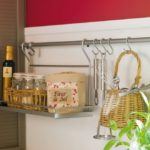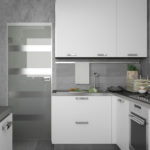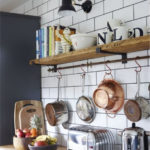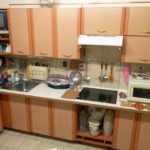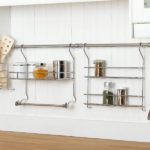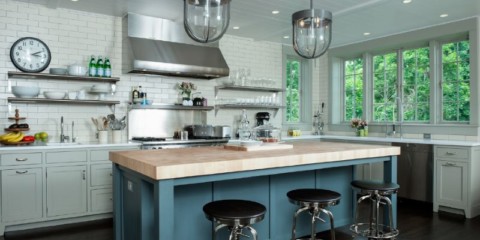 Kitchen
Beautiful design laws for beige cuisine
Kitchen
Beautiful design laws for beige cuisine
For those who want to have a practical, convenient, stylish and ergonomic kitchen area, be sure to pay attention to the railing systems that are popular today. Using them, free space on the desktop, and the cooking process will turn into a pleasure.

Rails - a practical solution for placing any kitchen utensils
Railing system. What is it?
Content
- Railing system. What is it?
- Types of systems
- Materials of manufacture
- Installation of rails
- Kitchen design and choice of railing system
- The main advantages of choosing a railing system
- Accessories: versatility and functionality
- Customer reviews
- Video on how to assemble and install kitchen railing
- Photo: roof rails in the interior of the kitchen
The word "railing", which came to us from English, meaning "railing", "rail", is a hollow crossbeam for hanging various kitchen accessories.

Only the name is complex in this system, the essence of the device is very simple and understandable
The idea of using roof railing systems in home kitchens came from catering enterprises and bars, where for convenience and speed of manufacture, the most popular accessories were always at hand for cooks and bartenders. In restaurants and cafes, horizontal kitchen rails were most often used, in bars vertical and hanging holders were practiced. Thanks to this find, the need to spend time and energy on finding the right thing at the moment in countless cabinets and drawers has disappeared.

The railing systems are selected for each kitchen individually, there may be several in different areas of the kitchen
The railing system for the kitchen consists of hollow tubes, as a rule, with a diameter of 16 mm long from 600 to 1800 mm, the ends of which are decorated with decorative caps. To fasten the rod for kitchen accessories, 2 fasteners for each railing are required (self-tapping screws with plastic dowels and couplings are included). Each tube is connected to each other at the attachment point of the holder. To connect two direct rails, in the case of a corner kitchen set, an angle of 90 or 135 degrees is used.

The device is a direct element of the railing system
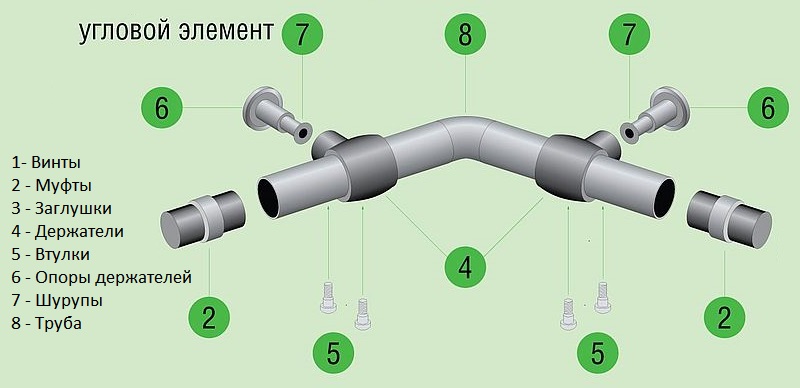
The device of the corner element of the railing system
Well, and, of course, a variety of hanging elements: single and double hooks, holders and shelves. All kinds of gadgets for the kitchen are placed on it: appliances, dishes, covers, graters, cutting boards, banks, organizers for appliances, jars, spices, tea and coffee utensils, towels, potholders and more.

Thanks to additional hinged fittings, a variety of kitchen appliances can be compactly placed on rails
Types of systems
Roof rails for the kitchen come in three types. The most commonly used horizontal railing system for the kitchen, as the housewives appreciated the convenience of location under the hinged kitchen cabinets and in any horizontal plane. They can be placed along all hanging cabinets, if it is rational or delimited by functional modules. The heart of each hinged system is all kinds of hooks and additional elements. The range of accessories is unlimited: hooks, shelves, trays, holders.

The easiest railing option - a straight tube with S-shaped hooks
A popular form of the system is magnetic railing for storing metal objects without hooks. It is especially convenient to store knives in this way.

The magnetic strip for knives mounted on the apron will free up space on the kitchen desktop
Vertical railing in the kitchen consists of a more massive base tube, compared with the horizontal system, and hinged elements: shelves and holders. They can be single-tier and multi-level. On the shelves of this system most often store dishes, cans, bottles, products. They are mounted between the cabinet and the countertop or from the ceiling to the floor.

Vertical rails are often equipped with bar racks.
Hanging kitchen railing is a single structure that is mounted to the ceiling. As a rule, this is a whole system where there is a place for utensils and other accessories. Bars use this advantage. Especially in demand by owners of island-type kitchens, where the system is located above the desktop.

Reiling in an original wooden case suspended on chains
Options for railing in the kitchen are presented in the photo.
Materials of manufacture
Railing in the kitchen is most often made of chrome steel in a glossy or matte version, from anodized aluminum, brass and nickel. Some manufacturers offer forged products, with wooden parts, the use of leather elements, and even high-impact glass with backlight inside.

Bronze railing stands out against the white brick wall and is one of the main accents of this kitchen.
All accessories of one series will be made in the color of the bar. Depending on the interior of the kitchen, you can choose roof rails with color spraying, bronze finish, silver, gold, brass, enamel or marble. In addition to the aesthetic effect, the spraying performs protective functions against metal corrosion.

The most expensive roof rails are made of stainless steel, they hold a lot of weight, and rust does not take them
Installation of rails
Horizontal rails for the kitchen are mounted at a distance of 40-50 cm from the countertop, if there is a cabinet or shelf on top, the distance from it should be 8-10 cm.

The number of fastening points of the railing is selected based on the expected load
Important! If the bar is longer than 900 mm, 3 wall mounts must be used to increase its functionality. The fasteners are installed evenly after 40-50 cm. The system must be strong and resistant to bending.
Mounting tool:
- building level;
- hammer drill or drill (you can use a drill with diamond spraying, if installed on ceramic tile);
- a hacksaw for metal or a grinder, if you need to remove the length.

Typically, railing is placed at a distance of 40-50 cm from the countertop, but you can choose a different suspension height depending on the filling system
Installation process:
- Draw a horizontal line in level at the required height.
- On the drawn line, symmetrically mark the points where there will be holes for the attachment points.
- Drill holes with care, being careful not to damage the surface of the kitchen apron.
- Using a hammer, hammer the plastic inserts from the self-tapping screws into the resulting holes.
- Fasten the coupling by screwing in the screws.
- Screw the holder onto the coupling.
- Insert the crossbar into the holder and fasten it with bolts and nuts using a screwdriver.
- Insert plugs around the edges of the boom.

Rail fixing scheme
For vertical railing, there are two fastening systems. The most convenient option is on special struts, without drilling the ceiling, floor or countertop. If drilling is needed, then the same steps are performed as in the previous version, only the attachment points are changed.
Note! The railing system for the kitchen is so easy to install that it does not require the involvement of a specialist and even a housewife can do it.

The railing can be attached to the wall of the kitchen cabinet, if it is convenient
Kitchen design and choice of railing system
If the kitchen is designed in one, strictly defined design, then the choice of railing should be approached, having certain knowledge.
- In the classical style, it implies facades of wood, it is appropriate to choose systems of stainless steel with powder colored coating in the color of gold, bronze, copper, antique brass. Hinged elements made of serogroffer glass add lightness to the headset.

Dark railing from a thin tube in the kitchen with a classic set
- Modern classics are the color variety of facades. Therefore, it is necessary to choose the most appropriate color railing system. Usually, this is a non-standard color scheme: white snow, sand, ivory, chocolate.

The railing can be matched to the moldings on the facades of the kitchen
- Modern, hi-tech styles suggest a choice of systems made in interesting rectangular shapes with a unique design. Material - stainless steel, glossy or chrome surfaces; anodized aluminum. Be sure to have a backlight that will create unexpected visual effects.
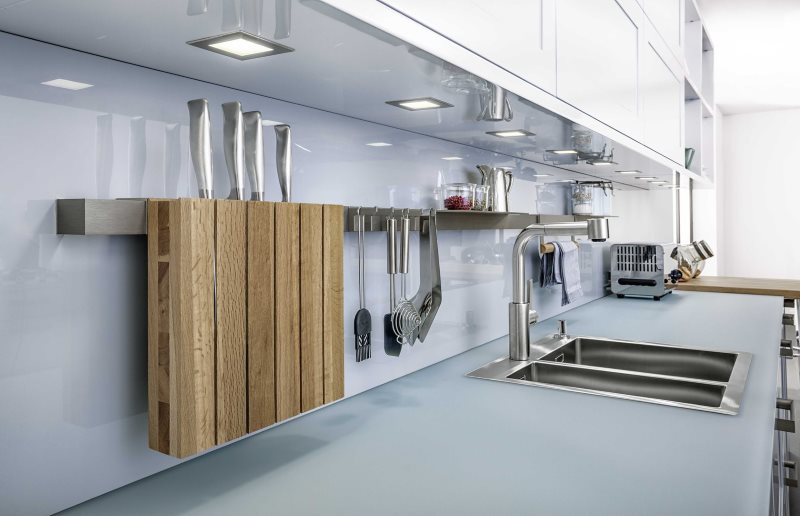
High-tech flat long brushed metal railing looks great in high-tech
- Retro style, vintage - these are natural materials, the choice is made of brass systems.

Copper or brass parts are successfully combined with dishes coated with the same alloy
- The style of Provence, country, Italian is characterized by pastel shades, simple shapes. There is a choice of roof rails for a specific kitchen, the color of facades, handles and other accessories.

A simple rule applies to a rustic interior - the simpler the better
- In a modern urban style, roof rails are very appropriate, the main thing is not to overdo it with small details.
Important! For kitchen sets made in the style of minimalism and Japanese style, the presence of railing systems is not welcome. This style prefers a minimum of detail, does not tolerate anything superfluous, therefore hanging small objects do not fit into this design.
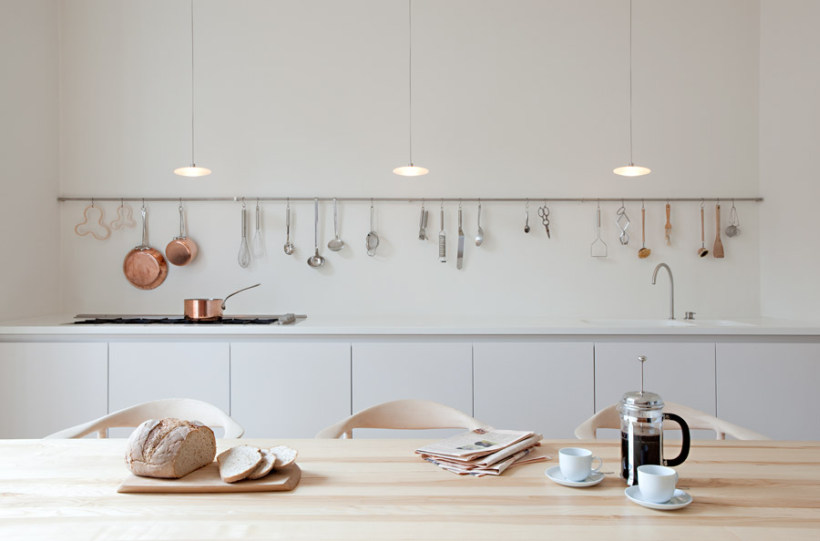
Some options can still fit into a minimalist interior, for example, as in the photo
But of course, everyone makes a choice for himself: to harmoniously complete the image of the kitchen or create a practical and comfortable space.
The main advantages of choosing a railing system
Not surprisingly, railing systems have become indispensable attributes in the kitchens. Thanks to them, the kitchen space is used more rationally and economically, the mass of free space in the working area is freed, the cooking process brings satisfaction and pleasure.
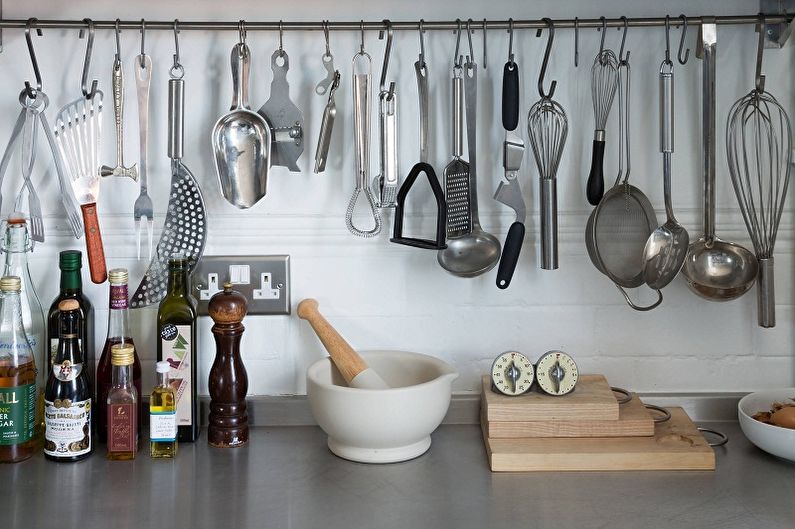
Even the simplest hook bar solves many problems.
Design Advantages:
- Allows you to functionally use the space above the work surface.
- Harmoniously complements and completes the image of the kitchen.
- Allows you to free the countertop from small kitchen utensils.
- All items are at hand.
- Simple design and easy installation, without much labor.
- Durability, withstands high loads without loss of shape.
- You can always add or remove additional attachments.
- All attachments are easy to move and remove, so it is possible to choose a more convenient option for the location of accessories.
- Low cost makes it possible to acquire them to a wide range of customers.
- Practical in care, just wipe them with a damp cloth.

On solid rails, you can hang anything, even pots with herbs and spices
Accessories: versatility and functionality
Kitchen apron rods cannot be considered without accessories for them:
- dryers for dishes, appliances and glass;
- all kinds of glasses;
- jars with a lid;
- holders for glasses, glasses, glasses;
- baskets;
- bread bins;
- hooks of various types and configurations;
- mesh shelves;
- universal shelves;
- shelves with a glass for kitchen utensils;
- shelves for spices;
- shelves for spices with jars;
- holders for paper towels, foil, paper, cling film;
- holder for kitchen towels;
- holders for knives, covers, table boards.
Shelves with a mesh bottom, of various designs and purposes, have special functionality. The mesh bottom does not allow liquids to linger and therefore they are simple and convenient in leaving in comparison with the closed shelves.

A dish dryer will be appropriate to place next to the kitchen sink
Shelves can be used depending on the zone in which they are located.
Round shelves are usually used in the washing area, for storing dishes, appliances, products after washing. And also for storing washcloths, sponges, detergents. Rationally place towel holders in this area.

Place the items that you use when washing dishes above the kitchen sink
In the cooking zone, multilevel shelves for spices, seasonings, napkins are most often used. Mandatory here are the holders for knives and kitchen boards. The same shelves can be placed in the brewing zone for tea, coffee, placing on them jars of tea, coffee, herbs and accessories for brewing.
In the hob area, it is worthwhile to arrange cooking equipment (shovels, soup ladle, tongs), potholders, shelves with spices.

There is no need to hang all kitchen utensils on roof rails, store on the wall only those items that you are used to holding on work surfaces
If the design is able to withstand heavy loads, you can place on the shelf medium-sized household appliances: toaster, mixer.
If the kitchen is small, it is recommended not to overload it with hinged elements, a few hooks and shelves will suffice.
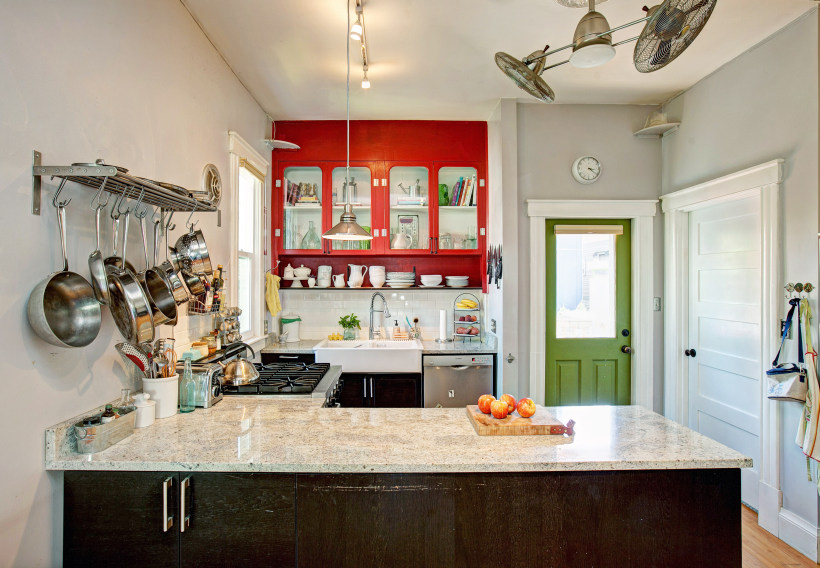
Use the wall space as efficiently as possible with roof rails
The corner kitchen gives the greatest opportunities for the distribution of shelves and hooks. On a short wall it is better to place a multi-level railing system with shelves and hinged elements.
Roof rails for the kitchen are a storage system and ensure convenience and comfort in the kitchen, which is their main advantage. Types of railing systems are diverse, are a necessary attribute in a modern kitchen. Made of high quality materials, have a wide color gamut. You can choose for any interior of the kitchen space. A variety of pendant elements and accessories gives unlimited possibilities for their variations.
Customer reviews
Nastasia: “Railings are not only convenient, but also beautiful! I have over my desk and sink. True, we have acquired rails of not very good quality, because "a hollow long pipe bends under the hanging shelves with spices, etc."
Skarlet: “The roof rails only spoil the whole look of the kitchen. After all, there are people who hang pans, boards, and everything that is available! But if I decide to install such a device, it is only because I do not know where to remove the ladles. Or just buy a set on a stand. In general, I am for there to be a minimum, both on the desktop and on the walls! ”
Video on how to assemble and install kitchen railing
